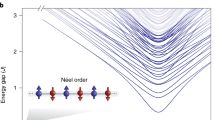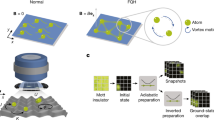Abstract
Extensions of Berry’s phase and the quantum Hall effect have led to the discovery of new states of matter with topological properties. Traditionally, this has been achieved using magnetic fields or spin–orbit interactions, which couple only to charged particles. For neutral ultracold atoms, synthetic magnetic fields have been created that are strong enough to realize the Harper–Hofstadter model. We report the first observation of Bose–Einstein condensation in this system and study the Harper–Hofstadter Hamiltonian with one-half flux quantum per lattice unit cell. The diffraction pattern of the superfluid state directly shows the momentum distribution of the wavefunction, which is gauge-dependent. It reveals both the reduced symmetry of the vector potential and the twofold degeneracy of the ground state. We explore an adiabatic many-body state preparation protocol via the Mott insulating phase and observe the superfluid ground state in a three-dimensional lattice with strong interactions.
This is a preview of subscription content, access via your institution
Access options
Subscribe to this journal
Receive 12 print issues and online access
$209.00 per year
only $17.42 per issue
Buy this article
- Purchase on Springer Link
- Instant access to full article PDF
Prices may be subject to local taxes which are calculated during checkout





Similar content being viewed by others
References
Chen, X., Gu, Z.-C., Liu, Z.-X. & Wen, X.-G. Symmetry-protected topological orders in interacting bosonic systems. Science 338, 1604–1606 (2012).
Wang, C., Potter, A. C. & Senthil, T. Classification of interacting electronic topological insulators in three dimensions. Science 343, 629–631 (2014).
Willett, R. et al. Observation of an even-denominator quantum number in the fractional quantum Hall effect. Phys. Rev. Lett. 59, 1776–1779 (1987).
Fu, L. & Kane, C. L. Superconducting proximity effect and Majorana fermions at the surface of a topological insulator. Phys. Rev. Lett. 100, 096407 (2008).
Deng, M. T. et al. Anomalous zero-bias conductance peak in a Nb–InSb nanowire–Nb hybrid device. Nano Lett. 12, 6414–6419 (2012).
Nadj-Perge, S. et al. Observation of Majorana fermions in ferromagnetic atomic chains on a superconductor. Science 346, 602–607 (2014).
Madison, K. W., Chevy, F., Wohlleben, W. & Dalibard, J. Vortex formation in a stirred Bose–Einstein condensate. Phys. Rev. Lett. 84, 806–809 (2000).
Abo-Shaeer, J., Raman, C., Vogels, J. & Ketterle, W. Observation of vortex lattices in Bose–Einstein condensates. Science 292, 476–479 (2001).
Gemelke, N., Sarajlic, E. & Chu, S. Rotating few-body atomic systems in the fractional quantum Hall regime. Preprint at http://arXiv.org/abs/1007.2677 (2010).
Jaksch, D. & Zoller, P. Creation of effective magnetic fields in optical lattices: the Hofstadter butterfly for cold neutral atoms. New J. Phys. 5, 56 (2003).
Kolovsky, A. R. Creating artificial magnetic fields for cold atoms by photon-assisted tunneling. Europhys. Lett. 93, 20003 (2011).
Lin, Y.-J., Compton, R. L., Jimenez-Garcia, K., Porto, J. V. & Spielman, I. B. Synthetic magnetic fields for ultracold neutral atoms. Nature 462, 628–632 (2009).
Aidelsburger, M. et al. Realization of the Hofstadter Hamiltonian with ultracold atoms in optical lattices. Phys. Rev. Lett. 111, 185301 (2013).
Miyake, H., Siviloglou, G. A., Kennedy, C. J., Burton, W. C. & Ketterle, W. Realizing the Harper Hamiltonian with laser-assisted tunneling in optical lattices. Phys. Rev. Lett. 111, 185302 (2013).
Struck, J. et al. Engineering Ising-XY spin-models in a triangular lattice using tunable artificial gauge fields. Nature Phys. 9, 738–743 (2013).
Jotzu, G. et al. Experimental realization of the topological Haldane model with ultracold fermions. Nature 515, 237–240 (2014).
Harper, P. G. Single band motion of conduction electrons in a uniform magnetic field. Proc. Phys. Soc. A 68, 874–878 (1955).
Azbel, M. Y. Energy spectrum of a conduction electron in a magnetic field. Sov. Phys. JETP 19, 634–645 (1964).
Hofstadter, D. R. Energy levels and wave functions of Bloch electrons in rational and irrational magnetic fields. Phys. Rev. B 14, 2239–2249 (1976).
Aidelsburger, M. et al. Measuring the Chern number of Hofstadter bands with ultracold bosonic atoms. Nature Phys. 11, 162–166 (2015).
Goldman, N., Dalibard, J., Aidelsburger, M. & Cooper, N. R. Periodically driven quantum matter: The case of resonant modulations. Phys. Rev. A 91, 033632 (2015).
Bukov, M. & Polkovnikov, A. Stroboscopic versus nonstroboscopic dynamics in the Floquet realization of the Harper–Hofstadter Hamiltonian. Phys. Rev. A 90, 043613 (2014).
Bilitewski, T. & Cooper, N. R. Scattering theory for Floquet–Bloch states. Phys. Rev. A 91, 033601 (2015).
Choudhury, S. & Mueller, E. J. Transverse collisional instabilities of a Bose–Einstein condensate in a driven one-dimensional lattice. Phys. Rev. A 91, 023624 (2015).
Aidelsburger, M. et al. Experimental realization of strong effective magnetic fields in an optical lattice. Phys. Rev. Lett. 107, 255301 (2011).
Atala, M. et al. Observation of chiral currents with ultracold atoms in bosonic ladders. Nature Phys. 10, 588–593 (2014).
Stuhl, B. K., Lu, H.-I., Aycock, L. M., Genkina, D. & Spielman, I. B. Visualizing edge states with an atomic Bose gas in the quantum Hall regime. Preprint at http://arXiv.org/abs/1502.02496 (2015).
Lim, L.-K., Hemmerich, A. & Smith, C. M. Artificial staggered magnetic field for ultracold atoms in optical lattices. Phys. Rev. A 81, 023404 (2010).
Möller, G. & Cooper, N. R. Condensed ground states of frustrated Bose–Hubbard models. Phys. Rev. A 82, 063625 (2010).
Powell, S., Barnett, R., Sensarma, R. & Das Sarma, S. Bogoliubov theory of interacting bosons on a lattice in a synthetic magnetic field. Phys. Rev. A 83, 013612 (2011).
Polini, M., Fazio, R., MacDonald, A. H. & Tosi, M. P. Realization of fully frustrated Josephson-junction arrays with cold atoms. Phys. Rev. Lett. 95, 010401 (2005).
Kohmoto, M. Topological invariant and the quantization of the Hall conductance. Ann. Phys. 160, 343–354 (1985).
Lin, Y.-J. et al. A synthetic electric force acting on neutral atoms. Nature Phys. 7, 531–534 (2011).
Polak, T. P. & Zaleski, T. A. Time-of-flight patterns of ultracold bosons in optical lattices in various Abelian artificial magnetic field gauges. Phys. Rev. A 87, 033614 (2013).
Ozawa, T., Price, H. M. & Carusotto, I. The momentum-space Harper–Hofstadter model. Preprint at http://arXiv.org/abs/1411.1203 (2014).
Parker, C. V., Ha, L.-C. & Chin, C. Direct observation of effective ferromagnetic domains of cold atoms in a shaken optical lattice. Nature Phys. 9, 769–774 (2013).
Haller, E. et al. Inducing transport in a dissipation-free lattice with super Bloch oscillations. Phys. Rev. Lett. 104, 200403 (2010).
Alberti, A., Ferrari, G., Ivanov, V., Chiofalo, M. & Tino, G. Atomic wave packets in amplitude-modulated vertical optical lattices. New J. Phys. 12, 065037 (2010).
Braun, S. et al. Negative absolute temperature for motional degrees of freedom. Science 339, 52–55 (2013).
Zurek, W. H., Dorner, U. & Zoller, P. Dynamics of a quantum phase transition. Phys. Rev. Lett. 95, 105701 (2005).
Umucalılar, R. O. & Oktel, M. Ö. Phase boundary of the boson Mott insulator in a rotating optical lattice. Phys. Rev. A 76, 055601 (2007).
Dubček, T. et al. Weyl points in three-dimensional optical lattices: Synthetic magnetic monopoles in momentum space. Phys. Rev. Lett. 114, 225301 (2015).
Kennedy, C. J., Siviloglou, G. A., Miyake, H., Burton, W. C. & Ketterle, W. Spin–orbit coupling and quantum spin Hall effect for neutral atoms without spin flips. Phys. Rev. Lett. 111, 225301 (2013).
Lewenstein, M., Sanpera, A. & Ahufinger, V. Ultracold Atoms in Optical Lattices: Simulating Quantum Many-Body Systems (Oxford Univ. Press, 2012).
Goldman, N., Juzeliūnas, G., Öhberg, P. & Spielman, I. B. Light-induced gauge fields for ultracold atoms. Rep. Prog. Phys. 77, 126401 (2014).
Cooper, N. R. & Dalibard, J. Reaching fractional quantum Hall states with optical flux lattices. Phys. Rev. Lett. 110, 185301 (2013).
Acknowledgements
We acknowledge Quantel Laser for their gracious support and use of an EYLSA laser for our main cooling and trapping light, G. Siviloglou and Y. Lensky for experimental contributions, and E. Mueller, S. Choudhury, A. Jamison, M. Lukin, S. D. Sarma, S. Parameswaran, E. Altman, E. Demler, N. Cooper and G. Möller for stimulating discussions. W.C.C. acknowledges support of the Samsung Scholarship. This work was supported by the NSF through grant PHY-0969731, through the Center for Ultracold Atoms, AFOSR MURI grant FA9550-14-1-0035 and ARO MURI grant no. W911NF-14-1-0003.
Author information
Authors and Affiliations
Contributions
All authors contributed to experimental work, data analysis and manuscript preparation.
Corresponding author
Ethics declarations
Competing interests
The authors declare no competing financial interests.
Supplementary information
Supplementary information
Supplementary information (PDF 413 kb)
Rights and permissions
About this article
Cite this article
Kennedy, C., Burton, W., Chung, W. et al. Observation of Bose–Einstein condensation in a strong synthetic magnetic field. Nature Phys 11, 859–864 (2015). https://doi.org/10.1038/nphys3421
Received:
Accepted:
Published:
Issue Date:
DOI: https://doi.org/10.1038/nphys3421
This article is cited by
-
Realization of a fractional quantum Hall state with ultracold atoms
Nature (2023)
-
Quantized fields induced topological features in Harper-Hofstadter model
AAPPS Bulletin (2023)
-
Tailoring quantum gases by Floquet engineering
Nature Physics (2021)
-
Programmable interactions and emergent geometry in an array of atom clouds
Nature (2021)
-
Cyclotron dynamics of a Bose—Einstein condensate in a quadruple-well potential with synthetic gauge fields
Frontiers of Physics (2021)



